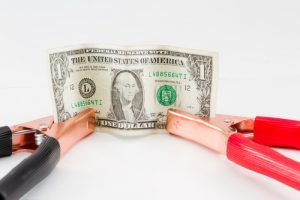-
Quick Contact
Get A free
Consultation Now!
Bad Credit
Is your bad credit score hurting your children?
 Your credit score has little or nothing to do with your children, you may think. After all, young ones aren’t even aware of what a credit score is for the most part, nor do they concern themselves with the level of your credit card debt or other boring “adult stuff.”
Your credit score has little or nothing to do with your children, you may think. After all, young ones aren’t even aware of what a credit score is for the most part, nor do they concern themselves with the level of your credit card debt or other boring “adult stuff.”
So, even if you’re maxed out on your cards with a sub-par score, it won’t affect them, right?
Wrong. In fact, numerous new studies point to the fact that there’s a direct link between how parents manage their credit, debt, and other money matters, and how children will do the same in the future. Even more important, you could actually be hurting your child in myriad ways if you’re behind on bills and keep a bad score.
“Sadly, your credit doesn’t just affect you, it also affects your kids,” says Michael Banks, founder of Fortunate Investor.
From missing out on private schooling, participation in sports, field trips, getting tutoring, and having a new computer for homework. Braces, trips to the doctor, and other medical needs may go unmet if parents have too much medical debt, not enough funds set aside, or don’t qualify for A+ insurance programs due to their credit scores.
College choices, and especially their choice of universities and later vocation, will be negatively impacted, and these kids will be forced to take on student loans, won’t have co-signers to help them with their first credit card or car loan, and take lower paying jobs out of desperation and need.
“Your children will need you at some point for financial help,” says Justin Lavelle, Chief Communications Officer for BeenVerified.com. “Don’t waste away your financial future and your child’s hopes and dreams because you have sloppy money habits.”
These kids-now-adults will also lack the accurate and unemotional knowledge about debt, savings, and investing. So, point blank, the environment at home around credit and debt matters.
Research also shows that children do pay attention to their family’s finances, but not in ways you may think. Information filters in not in dollar figures and statistics, but in stress levels, perceived anxieties, topics that are taboo, and suggestions about their place in the world or society.
Furthermore, children whose parents have high levels of debt and low credit scores (which is different than just parents on the low end of the wage-earning scale), miss vital opportunities in life that may hinder their potential development as adults.
There even could be developmental or behavioral implications to your high debt/low score burden.
New studies even reveal that children whose parents have certain kinds of financial debt are more apt to have behavioral problems. In a study of 9,000 children ages 5 to 14 conducted by the University of Wisconsin-Madison, researchers found that children of parents with high unsecured debt, such as credit cards or medical bills, were more likely to experience anxiety, emotional stress, aggression, and even depression.
“Growing up in an environment of constant financial worry can cause your children to ‘inherit’ those same concerns and carry them into their adulthood,” says Marc Johnston-Roche, founder of Annuities HQ.
However, it’s worth noting that there wasn’t such a correlation found between secured debt levels and children’s wellbeing. That’s because secured debt tends to go towards more positive and utilitarian purposes, such as getting a mortgage to buy a house, some student loan debt to pursue a degree, or taking out a business loan so the family can improve their financial situation.
Those findings are confirmed by a first-of-its-kind study by Dartmouth College which discovered that how parents handle their credit has socioemotional implications. In their research, children of parents with higher levels of unsecured debt (credit cards, payday loans, and medical debt), were more likely to suffer from “poor socioemotional well-being.”
“High levels of unsecured debt may create stress or anxiety for parents, which may hinder their ability to exhibit good parenting behaviors, and subsequently affect the wellbeing of their child or children,” the study reported.
But there is potentially good news for children when parents do manage their credit – and communicate positively about it. A landmark study conducted by North Carolina State University and the University of Texas concluded that parents who were more likely to sit down and talk with their kids about credit, debt, saving, spending, and earning, even from a young age, give their children a head start for the future.
But, interestingly, the study also found that certain topics were often taboo or off-limits during family discussions about finances, like parental income, investments, and, yes, debt. They also found that parents were more likely to talk with their boys about investing and other matters than with their daughters – a concerning trend.
So, what’s the takeaway?
If you have a bad credit score, your children are statistically far more likely to have bad credit scores as they get older, too. And if you max out your credit cards and carry a lot of “bad” debt, you’ll likely pass that pattern on to your kids. No matter how well-intentioned you are, right now, you’re actually modeling what financial behavior should look like to your children – and they’re learning quickly.
You now have another compelling reason to clean up your credit and right your financial ship: keeping your children out of the same predicament.
The Pyramid of Financial Success
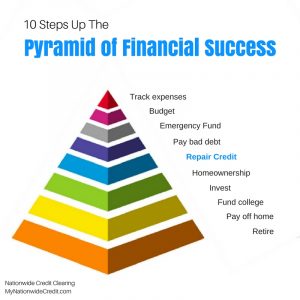 The Pyramid of Financial Success
The Pyramid of Financial Success
No matter what our financial situations look like, everyone pretty much wants the same thing: low bills, plenty of savings, living in our own home, and enough investments to retire whenever we wish. Achieving that lofty goal is also very obtainable if you follow these 10 steps to climb the Pyramid of Financial Success:
1. Track expenses
Before you do anything else, it’s critical to know exactly how much you’re spending every month, and on what. Sure, you may THINK you know what your bills are and how much you spend, but I bet that you’ll be pretty shocked when you write down every single penny you spend (or use one of the great financial apps that help you record expenses). Try this for a month and then add up the total expenses and you’ll be amazed how much you’re blowing on impulse purchases, things you don’t really need or even want, and items that you didn’t realize are costing you!
2. Set a budget
Now that you know exactly what you’re spending your hard-earned dollars on, it’s time to tighten the belt. Ruthlessly slash everything from your budget that’s not a necessity – and hold yourself accountable to it. This will take some discipline but turn it into a fun game, and keep reminding yourself that by sacrificing NOW, you’ll be able to put yourself in a much better financial situation that lets you spend more on the things you really love and want later on.
3. Build an emergency fund
Did you know that 40 percent of Americans couldn’t come up with $400 in cash if faced with an emergency today, and two-thirds don’t have even $1,000 saved? As we’ve turned to debt more and more, the savings deficit in the U.S. has grown. However, it’s so important that you accumulate a rainy-day fund, which is a fair bit of cash that you can use when the car breaks down, you miss work because of a medical problem, or some other challenge. Start by putting $400 away, then $1,000, and keep saving until soon, you’ll have at least a few month’s total expenses saved as a cushion.
4. Pay debt
This is a big one! Once you’ve set a budget and put aside a few bucks as a safety net, it’s time to tackle the hardest part of all: paying off debt. In fact, the average American household now has $16,883 in credit card debt, $50,626 in student loans, $29,539 in auto loans, and, if they’re lucky, a mortgage on top of all that. But the one that we want to start with is paying off credit cards, as well as other revolving debt and retail installment loans. This is essential if you want to free yourself from a life of struggling and stressing about money and bills, and open up a much more secure and comfortable relationship with money.
There are several ways you can pay off your debt, but one of the best is using the technique of Debt Snowballing which is advocated by financial gurus Dave Ramsey, Suzie Orman and others. We’ll bring you more info on Debt Snowballing soon.
5. Repair credit
In fact, it’s a good idea to tackle #4 and #5 on this list in conjunction so that you’ll end up debt free AND with a fantastic credit score, starting with a free credit report and consultation from Nationwide Credit Clearing. We’ll go over your credit report and debt load with you, identifying which of them should be paid off first since they have the highest interest rates (or smallest balances).
Likewise, we can advise you which of your credit accounts should just be paid down (not off) and kept open. Our service will also attempt to remove negative, incorrect, and outdated items from your credit report, boosting your score to new heights.
How important is a great credit score? These days, just about everything you pay is tied to credit score, from all of your credit cards, your mortgage, and other loans, as well as utilities, cell phone accounts, the ability to rent a home, and even your job!
6. Buy a house
Speaking of (not) renting, once you have some savings and your debt paid off, the next big step in your financial pyramid is buying your own home. In fact, homeownership is still the American Dream, allowing you to build equity, pay down your loan, enjoy lucrative tax breaks, and experience the pride of ownership. These days, down payment programs make it easier than ever to come up with the money needed to buy a house, and you’ll essentially be paying yourself every month instead of your landlord!
7. Invest
Your bad debt is gone, and you’re now in your own home, so it’s time to start investing. Actually, you should be investing from day one in a 401K, mutual fund, or other safe, stable vehicle, as the power of compounding really comes into play the earlier you start. Contact a financial planner or advisor for the best way to invest and save for retirement considering your situation and goals.
8. Fund college
Remember how we mentioned that the average household has $50,000+ in student loan debt? Why not give your children a head start (not extra hurdles) in life by funding as much of their college education as possible instead of piling on more debt?
9. Pay off your home
We paid off your bad debt when we zeroed-out those credit cards, and you’ll get to a point high up the pyramid of financial success where the next logical step will be to pay off your home, too. There are several great strategies to help you do this, such as sending in a 13th payment every year, paying every two weeks instead of monthly, or adding extra funds to pay off principal faster. Either way, once you pay off your home in 20 or even 10 years instead of 30 (like most mortgages), your biggest bill will be knocked off the list.
10. Retire
With little or no debt, plenty of savings, a well-spring of investment income, and your home paid off, you’ll be in the enviable position at the top of the pyramid, where you can choose to retire whenever you like. Of course, that doesn’t mean that you must stop working, as many people opt to pursue their passion or work a lighter schedule just because it’s enjoyable. Either way, you’ll be the master of your financial life – not the other way around! Congratulations on making it to the top of the pyramid!
How long will negative information stay on our credit reports?
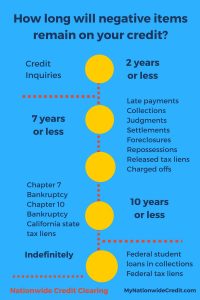 How long will negative information stay on our credit reports?
How long will negative information stay on our credit reports?
Did you miss a credit card payment, have a bill go to collections, or even had to file bankruptcy recently? If so, your credit score has probably taken a pretty big hit. You’re also probably wondering when it will stop showing up on your credit report so you can move on.
Luckily, negative information that’s reported on your credit doesn’t last forever. In fact, we know the timeline when they will “fall off” and not be reported anymore thanks to the Fair Credit Reporting Improvement Act of 2014, which defines the timelines for how long negative information can remain on your credit file.
Here’s a rundown of how long common items will remain on your credit report, where they very well could be hurting your score:
Credit accounts
Credit cards, store cards, retail accounts, auto loans, and other credit accounts that are paid on time can keep reporting on your credit for up to 10 years from the date of last activity.
Late payments for credit accounts
However, if you missed payments or failed to pay on time, that negative data will also be reported, but for a period of 7 years (starting from the exact date the account was first past due.)
Late payments for other debts
While late payments on common credit accounts will show up for 7 years, those same rules don’t apply for revolving or installment loans. In fact, if you have a revolving or installment debt that is now current but does have a late payment some time in the past, that negative item (late payment) will appear on your credit report for 10 years past the date of last activity.
While it may get a little confusing, the late payment history will be removed for these installment and revolving debts after 7 years, but the reporting for accounts that are current will show up for 10 years.
Collections
Collection accounts usually will show up on your credit report for a full 7 years after the date the account first became past due. Remember that the date it was past due will be earlier than the date it was sent to collections, which could be 90 days or more after that.
Bankruptcies
If you’ve been through a chapter 7 bankruptcy (most common for consumers), a chapter 11 bankruptcy, or a non-discharged or dismissed chapter 13 bankruptcy, that will typically keep reporting for 10 years from the date the bankruptcy was first filed (not the date they were discharged).
However, chapter 13 bankruptcies that have been discharged can only stay on your credit report for 7 years from the date they were first filed.
Public Records
Judgments usually stay on your credit report for 7 years after the date they were filed, whether you have satisfied (paid) them or not.
If you have a tax lien and then pay it off in full, the lien will still report on your credit for 7 years from the day it was satisfied.
However, tax liens that go unpaid (unsatisfied) will stay on your credit report indefinitely – which means that you’re stuck with them until they’re paid off.
Inquiries
When a third-party requests a copy of your credit report (usually a lender, retailer, or employer), that activity shows up on your credit report, and can possibly impact your score. But the good news is that there’s usually not a big hit, and the credit bureaus only keep this on your report for 1 or 2 years.
But there are different types of credit inquiries that might have different reporting timelines. For instance, promotional inquiries (when you received a pre-vetted offer for credit) don’t affect your score and generally remain on your credit for only 12 months. When one of your current creditors performs a review of your account, it also does not affect your score and remains for 12 months. Finally, when you request a copy of your own credit report, it does not affect your score and will remain on your credit file for up to 24 months.
However, there are some slight variations on these timelines depending on state law:
For instance, in California, paid or released tax liens will stay on your credit file for 7 years from the date released, or ten years from the date filed. And unpaid tax liens remain on your credit file for only ten years from the date they were filed – not indefinitely.
New York State residents see their satisfied (paid) judgments only remain on their credit file for 5 years and paid collections only reporting for five years from the date of last activity.
***
I know – that’s a lot to remember. So we’ve put together this easy list so you can quickly see how long a certain negative item will stay on your credit report:
The item remains two years (or less);
Credit Inquiries
The item remains no more than 7 years:
Late payments
Collections
Judgments
Settlements
Foreclosures
Repossessions
Released tax liens
Charged off accounts.
Note: the timeline begins from the date of default OR 180 days after the date of the first delinquency that eventually went to collection.
The item remains no more than 10 years:
A Chapter 7 bankruptcy can remain on a credit report for up to 10 years from the date it was first filed.
A Chapter 13 bankruptcy can also remain on a credit report for up to 10 years.
The item will remain indefinitely (until paid):
Federally guaranteed student loans that are unpaid and in default can remain on a credit file indefinitely until such time as they are paid.
Unpaid tax liens may report on a credit file indefinitely.
***
Remember – there’s another way to get rid of negative items that are reporting on your credit BEFORE they naturally fall off after all of these years! Contact us for more information!
How men and women differ when it comes to credit and debt.
 How men and women differ when it comes to credit and debt.
How men and women differ when it comes to credit and debt.
There are some profound differences between men and women when it comes to men and women, from what we earn, to what we spend our money on, and even how we go about investing. When it comes to credit and debt, there are some interesting comparisons between males and females, too – although it might not always be what you think.
For instance, when it comes to credit score, would you guess that men or women are leading the way with better scores?
In fact, according to surveys by Experian, women have a higher average credit score (675) than men (674).
Men have more debt, with an average of $26,227 compared to $25,095 for women.
The average man owes $5,282 in credit card debt, compared to only $4,867 for women in credit card balances.
Women have 4.1 credit cards on average, while the average man only carries 3.7 cards.
But at least part of that debt total for men can be attributed to home loans. Of all people who are mortgage holders, men have an average of $187,245 in home loans compared to $178,140 for females.
In fact, the average U.S. man has $50,425 in mortgage debt versus only $35,116 for the average American woman.
Another check in the “Men” column is that 60% of men have more savings than credit card debt, while only 49% of women have more in their savings account than their credit card balances.
While both sexes sometimes exhibit less than stellar use of credit cards, women lead the way in a metric called “problematic behaviors” when it comes to cards.
In fact, only 33% of men display two or more problematic behaviors with credit card usage, compared to 38% of women.
But men carry a larger total of debt than women (+4.3%), and females also use only 30% of their available credit, while men use 31% or higher on average.
Men comparison shop for better rates and terms on their credit cards more than women (37% to 31%).
Women also carry a bigger balance from month to month on their cards (60% do so) compared to men (55%).
And 42% of women only make the minimum payment every month, compared to only 38% of men (a big no-no for your credit score).
Backing up that statistic, 45% of men pay their balance in full every month, compared to only 39% of women.
Women also pay late fees on their credit cards far more than men, at a rate of 29% (of women who have to pay late fees) versus only 23% of men.
Despite having lower credit scores (slightly), men also have better interest rates on their credit cards than women. In fact, the average rate for men is 14.3%, compared to 14.9% for women’s credit cards.
How about student loan debt? On a per-student basis, women have far more student loan debt than men. In fact, the average woman has $11,786 in student loans, compared to only $8,187 for men.
But men finance far more for their cars, with an average auto loan tally of $8,249, while women only owe $6,693 on their car loans on average.
While the one-point credit point advantage favors women by a small margin, the data reveals that women do have a better understanding of credit scores and credit reporting. The Experian study concluded that:
48% of men incorrectly believe that marital status factors into credit scores, compared to only 38% of women who mistakenly think the same thing.
46% of men mistakenly think marital status is a factor in scoring, versus only 34% of women who get that wrong.
74% of women understand that the credit bureaus collect the information that’s used for scoring, while only 68% of men realize that.
Women are more apt to know when scores are free (65%) than men do (60%), know when lenders are mandated to discloses scores (53% to 46% for men), and better understand the importance of regularly checking and monitoring their credit reports (77% to 72% for men).
***
So which gender wins the title of “Best with Credit and Debt?” It seems like women win out over men on average in certain important factors, but men are profoundly better in a few others. Overall, well call it a tie and just say that BOTH men and women need to work hard, educate themselves, and do better with credit and debt if they want to improve their finances and get ahead!
And you can start with a free credit report and consultation from Nationwide Credit Clearing! Contact us to get started.
The difference between hard and soft credit inquiries.
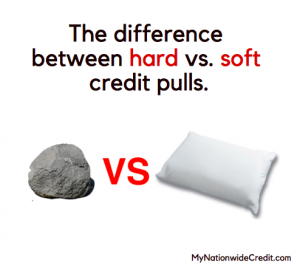 Most people check their credit periodically, such as when they’re about to apply for a big loan, once a year, or every four months (like you should). But you may not realize that a whole lot of others are checking your credit – and probably on a more frequent basis. In fact, every time you apply for a credit card, submit an application for a student loan, take out a store discount card, or even apply for insurance or rent a new apartment, your credit is probably being pulled.
Most people check their credit periodically, such as when they’re about to apply for a big loan, once a year, or every four months (like you should). But you may not realize that a whole lot of others are checking your credit – and probably on a more frequent basis. In fact, every time you apply for a credit card, submit an application for a student loan, take out a store discount card, or even apply for insurance or rent a new apartment, your credit is probably being pulled.
Those credit pulls also can ding your credit score, if not handled correctly. Sometimes, that’s inevitable, and other times it’s avoidable. But it’s important to understand the facts about hard and soft credit inquiries, or credit “pulls.”
In fact, only 26% of women and 31% of men know the difference between “hard” and “soft” credit inquires, or credit “pulls.”
So today, we’ll give you some fundamental information about credit inquiries, both hard and soft. Contact Nationwide Credit Clearing if you have further questions about credit pulls, and would like a free copy of your credit report and consultation with a credit expert!
Hard credit pulls:
Hard credit pulls only take place when you apply for new credit accounts.
Or, a hard pull will occur when one of your existing creditors decides to pull your credit. In fact, most creditors can access your credit any time, for any reason they deem, without needing your permission first.
Creditors commonly do this when they’re reviewing your account to consider an increase to your credit line.
Soft credit pulls:
Sofer credit pulls, however, can occur either with inquiries where the consumer voluntarily agreed to have their credit accessed, or other involuntary inquiries.
For instance, soft pulls usually take place when you’re applying for a new job, a cell phone account, trying to rent an apartment, etc.
Effect on credit score:
There is no one set rule for how credit pulls will affect your score. But, typically, hard credit pulls will only have a slightly negative impact on your credit score, possibly dropping your score a few points in the short term.
Typically, your FICO score can go down about 5 points per inquiry if you have your score pulled too much by the wrong vendors. The drop could be greater if you have few accounts or a short credit history without seasoned, positive factors to compensate.
In fact, the negative effect of hard pulls usually last only one year, but most of the damage disappears within the first 90 days.
Are all credit score pulls considered equal?
Since credit scoring is primarily a means of gauging the risk of default, consumers with high credit scores will suffer a little more damage from hard credit pulls. That’s because the credit algorithms consider the fact that they’re getting their credit pulled atypical, and more of a red flag.
So the higher your score to begin, the more damage a hard credit may do.
Additionally, unsecured credit inquiries, like you’ll find with personal credit cards, retail cards, and in-store accounts, will cause the most damage to your score.
When current creditors pull your credit:
We are certain that soft credit pulls have a negligible negative effect on credit scoring – or none at all. That’s the reason why most of your current creditors will only order soft credit pulls on your account, not hard pulls.
Current creditors usually also do a soft pull every month or so, although some check up on their consumers much more frequently.
Some credit pulls always act as hard inquiries, some are always soft injuries, and some can show up as either/or.
Hard pulls are most often found with:
• Applications for new credit cards
• Requests t activate a pre-approved credit offer (such as you receive in the mail)
• Applying for a new cell phone account and contract
Soft pulls are most often found with:
• Background checks by potential employers
• Your bank verifying your identity
• Initial credit checks by credit card companies that want to issue you preapprovals
Who can pull your credit, whether through hard or soft inquiries?
Lenders
Mortgage companies
Student lenders
Banks
Credit card companies
Financing departments of retail stores
Auto dealerships financing departments
Utility companies
Cell phone companies
Employers
Landlords
Insurance companies
Collection agencies
Child support agencies
Court agencies
Anyone with “Permissible Purpose,” as deemed by the Federal Credit Reporting Act.
Timing is everything with credit pulls:
Timing is so important when it comes to credit pulls. The more “bad” inquiries that appear on your report within a short time, the bigger hit to your score. For instance, if you apply for five new credit cards within a two-week period, it definitely is seen as risky to the credit bureaus, and your score will drop accordingly.
However, the credit bureaus do account for consumers who want to “shop around” for large and important loans, like mortgages, business loans, etc. Of course, shopping for the best rate on a single loan (not applying for multiple loans at once) means getting your credit score pulled several times within a short period, but the good news is that this practice won’t hurt your credit score.
In fact, the credit bureaus typically just count this group or batch of inquiries as one if they’re within a 30-day period (or a 45-day period with some credit scoring versions).
So, if you’re shopping around for the best rate on an important loan, try to contain all credit pulls to within a 30-day period to keep your score in good order!
***
Contact Nationwide Credit Clearing if you have further questions about credit pulls, and would like a free copy of your credit report and consultation with a credit expert!
How much will a late payment drop your credit score?
 Sometimes, life happens. Maybe you went on vacation and forgot to send off your credit card payment before you left, or you did send it off (you swear!), but it was lost in the mail. Or, you just flat-out didn’t have enough money to pay a bill, so the late notices are piling up.
Sometimes, life happens. Maybe you went on vacation and forgot to send off your credit card payment before you left, or you did send it off (you swear!), but it was lost in the mail. Or, you just flat-out didn’t have enough money to pay a bill, so the late notices are piling up.
When that happens, you may be wondering how far your credit score will drop, as the payment becomes 30, 60, and then 90 days later – or more.
The answer is, like so many questions in life, “It depends.” However, we do have some factual information and a few guidelines to go by.
For instance, we do know that paying on time is a major factor in how our credit scores are calculated. In fact, according to FICO, payment history makes up 35% of your credit score.
That being said, there is some gray area when it comes to the credit score damage a late payment can cause.
Here are five factors that help determine just that:
- Was it a 30, 60, or 90-day late payment?
Missing a payment’s due date by 30 days is the first huge milestone that will affect your credit, but continuing to miss that payment by 60 and then 90 days will impact your score even further. Remember that credit reporting is all about gauging risk (for potential lenders and creditors). So while a 30-day late may be explainable as a mistake, oversight, or one-time error, 60 or 90-day lates show that you are really in a financial freefall. Therefore, your score will drop accordingly, so you should definitely avoid a 90-day late payment if you want to save your score.
- How long ago was the late payment?
Credit scoring algorithms also factor in recency – how long ago the late payment took place. So if a 30,60, or 90-day late just hit your credit report this month, your score will drop a lot sharper than if the same late payment occurred five years ago. But that also means that as time goes on (and you continue to make your payments on time) the negative scoring
- Was it just one account with a late payment – or more?
If you’ve only missed a payment with one credit line, loan, or account, it will damage your score a lot less than if you’ve missed payments over multiple accounts.
- What type of credit account did you miss a payment for?
Of course, the credit reporting algorithms give more weight to more important loans, like mortgages, etc. over smaller ones, like a $250 store retail card. Therefore, a 30-day late payment on a mortgage loan will hurt your score a lot more than with smaller and lesser accounts.
- How long have you had that account?
Accounts that are well seasoned – that have been open and in good standing or a long time – will take less of a hit than newer accounts. So, avoid missing payments on that brand new credit card!
- What was your score before the late payment?
Believe it or not, the BETTER your credit was before the late payment, the MORE the late will hurt your score! Are you be punished for having a great score? NO; but the credit bureaus are gauging risk, and a late payment that’s out of character for a high-scorer is more alarming than the same late for someone who commonly makes credit missteps.
A 30-day late on your credit report will probably result in a credit score drop of around 80 points IF your score was originally around 680 or so. But if your score started out at 780 or higher, one late payment could send your score plummeting by 90-110 points!
Ouch!
However, if you’ve missed a payment, there are some ways to do damage control. Immediately contact your creditor and work out a payment, and you can even ask them to delete the negative blemish on your credit if and when you pay.
But different lenders report on different days of the month, so you may get lucky and prevent them from even reporting a 30, 60, or 90-day late. Again, you definitely want to avoid paying 90 days late on any accounts, as that will cause significant damage to your credit – and stay on your report for seven years!
The good news is that Nationwide Credit Clearing is here to help you clean up your credit and improve your score! Contact us if you have any questions about late payments or for a free credit report and consultation!
10 More things you didn’t know about credit scores, credit reporting, and debt in America
 Your credit score impacts so much in your life these days, from rent and homeownership to credit card approvals, interest rates on student and auto loans to even employment. But too often, we’re still in the dark when it comes to credit scores, credit reporting, and general financial knowledge about debt management.
Your credit score impacts so much in your life these days, from rent and homeownership to credit card approvals, interest rates on student and auto loans to even employment. But too often, we’re still in the dark when it comes to credit scores, credit reporting, and general financial knowledge about debt management.
As the nation’s leader in credit repair solutions, Nationwide Credit Clearing is committed to help educate you about these important topics. This is part two of our ongoing series, 50 things you didn’t know about credit score, credit reporting, and debt. Look for part one here, and contact us if you have any questions or credit issues at all!
1. Which company earns the title as the most popular credit card in the rest of the world? That honor belongs to both Mastercard, which has 551 million cards issued throughout the world as well as 180 million cards here in the United States. However, Visa wins top-dog honors on home soil, with 278 million cards floating around the U.S., as well as 522 in the rest of the world.
2. It’s no surprise that people often turn to their credit cards to pay bills and living expenses once they are unemployed, In fact, 86 percent of low and middle-income households who have a working member that is now unemployed turn to credit cards to fill the gaps monthly.
3. Likewise, almost 50 percent of low and middle-income households now are carrying credit card debt that comes from out of pocket payments they have to make on medical bills and expenses.
4. It’s interesting to look at a map and compute the average credit score for each state (OK, I don’t get out much!). In fact, the states with the lowest average credit scores are in the south and southwest, including New Mexico, Texas, Oklahoma, Arkansas, Louisiana, Mississippi, Tennessee, Georgia, Alabama, South Carolina, Nevada, and Florida. In those states, an alarming 40 percent of the population have subprime credit scores!
5. However, the states with the highest average credit scores are found in the north and midwest. Minnesota and North Dakota are the states with the highest average credit scores, with 707 and 700 average FICOs, respectively.
6. Aside from the state you live in, there are some other puzzling correlations between the heights of your credit score and your seemingly unrelated behaviors. For example, one study found a direct correlation between credit scores and which email provider the participants used! They found that Comcast email user (692 average) and Gmail, (682) have above average scores, but MSN (669), Aol (668) and Yahoo! (652) email users have below average scores.
7. But more common-sense correlations also apply. For instance, there are significant differences in credit scores based on age. Baby Boomers and the Silent Generation (68-85 years old) have average scores of 700 and up, while Gen Xers average a 655 score, Millennials average a 634 score, and Gen Z is lagging with a 631 average Vantage Score.
8. One correlation that we could have easily predicted is that between scores and homeownership, In fact, a Federal Reserve study found that the average credit score among homebuyers and homeowners is 728 – significantly higher than the national average. Additionally, they found that only 6.8% of homebuyers or homeowners had scores below 620 in the study.
9. We hear about our credit scores impacting home ownership, credit cards, interest rates on other loans, renting, and even employment. But did you know that your credit score can make a big difference on…your dating life? It’s true! According to a 2016 Bankrate survey, almost 4 in 10 U.S. adults say that they’d rather date someone with a good or excellent credit score, but they’d be wary of dating a sup-prime suitor. In fact, 43% of women and 32% of men said that a person’s credit would have an impact on if they dated them.
10. Americans are still pretty mixed up, confused, and turned around when it comes to basic knowledge of credit scores and credit reporting. In fact, studies have shown that of an average sample Americans, 47% didn’t know that credit scores are used by non-creditors like electric utilities and home insurers, 68% didn’t know that cell phone companies use credit scores, and 32% had no idea that landlords could check their credit!
***
Do you have questions about your credit or looking to improve your score? Contact Nationwide Credit Clearing for a FREE credit report and consultation at (773) 862-7700 or mynationwidecredit.com!
5 Ways to jump-start your credit score.
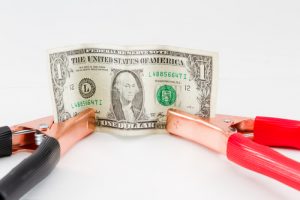 Is your credit score far less than ideal these days? If your FICO is lagging, just like about 30 percent of all Americans, it may be holding you back from getting a better credit card, applying for a mortgage loan to buy a house or even being hired for your dream job.
Is your credit score far less than ideal these days? If your FICO is lagging, just like about 30 percent of all Americans, it may be holding you back from getting a better credit card, applying for a mortgage loan to buy a house or even being hired for your dream job.
But the good news is that there are strategies you can use to build your credit, raising it to the point that you are considered a prime candidate for the best interest rates and credit approvals from banks, lenders, and other financial institutions.
Some of these strategies are part of a long-term plan to maintain good credit, but we also have ways to almost instantly boost your score.
If you are planning to apply for a home mortgage, finance a new car, or try to get a job that checks credit as part of the hiring process (like about 45 percent of all employers these days), you’ll want to utilize these five tactics.
Remember that Nationwide Credit Clearing is the U.S. leader in fast, effective, and affordable credit repair, so call us if you’d like a free credit report and consultation to get started!
- Pay down balances.
We know that the ratio of your debt to total available credit – called credit utilization ratio – makes up about 30 percent of your credit score. Therefore, people with maxed out credit cards or high debt loads compared to their available credit will see their scores steadily sinking.
So, the first thing you want to do when improving your credit score is to pay down as much debt as possible.
It’s important to get your credit utilization ratio below 30 percent (so you only owe $3,000 or less on a credit card with a $10,000 available balance). Credit experts even suggest keeping a utilization ratio of 10% or less to achieve a great credit score. However, don’t go all the way to 0% because it won’t show an established payment history they can use in their calculations (since you won’t have any payment).
- Request a credit line increase.
Don’t have enough money sitting around to pay down your credit balances enough to raise your scores? Another sneaky-good way to improve your credit utilization ratio – without paying down one cent of debt – is to increase your total available credit. For instance, let’s say you had a $10,000 credit line but owed $4,000 (so your utilization ratio was 40 percent).
Instead of paying down your debt, if you could get the credit card company to increase your available limit to $15,000 from 10k, your utilization ratio just went down to about 27 percent – and your score would go up! To do this, simply call the credit card company or lender and make your case over the phone and they’ll either approve or deny your request or approve a lesser increase.
- Ask your creditors to remove late payments from your credit report
Did you know that you can simply ask your creditors to remove evidence of late payments from your credit report? Why not? It’s free for you to ask (nicely), and the worst thing they can say is “no.” Called ‘Goodwill late-payment removal,’ this practice is more common than you may think. In fact, any creditor has the power to remove a late payment from your credit report.
For instance, department store credit accounts and other retail accounts are usually pretty liberal with goodwill late-payment removals. They may do just that if you can make a good case that it was a one-time incident because you didn’t receive the bill on time, an address change, etc. and that you otherwise have a perfect record with them.
Once they tell you that the late payment is removed, ask for payment history update letter, which is your confirmation in case you need to present documentation to the credit bureaus.
- Pay for deletion of collections
Many of us have collections on our credit reports, which can do some serious and ongoing damage to your score But there may be a way to get it removed. If you’ve missed enough payments to have an account in collections, your creditors may agree to erase any negative credit reporting for that account if you pay it off.
The good news is that you can also negotiate your payoff, and if it’s in collections, they may accept less than the full amount to settle you up – sometimes even 50 percent of your balance or far less!
Once you negotiate the payoff amount AND they agree to remove the item from your credit report, only pay the collection via a mailed certified check, with “Cash only if you delete account from credit report” written above the endorsement line. Also, make sure you get their promise in writing via a letter of deletion. We can use the letter to apply for a rapid rescore instead for you, so you won’t have to wait a month or more to see your credit score rise!
- Dispute any errors on your credit report.
Most people don’t realize that credit reports often contain mistakes, misreporting, duplicate items, or outdated information. All of these things may be lowering your score, but they can also be removed. Start by contacting Nationwide Credit Clearing for a copy of your credit report, and we’ll help you review it carefully for any errors or inaccuracies.
By reviewing it line-by-line, we’ll be able to highlight inaccuracies or items that are lowering your score. Remember that there are three major credit bureaus and they each may report different information, so it might be a good idea to check all three. Look for errors on larger accounts first, length of history, payments reporting on time, and that your balances are accurate.
The last step is formally disputing each inaccuracy or error with each of the credit bureaus, Equifax, Experian, and TransUnion, separately. They are legally obligated to get back to you in a certain amount of time with proof that the information you’re disputing is correct – or they have to change it or remove it.
***
If you have more questions about disputing items, how to boost your score quickly, or want a free copy of your credit report, contact Nationwide Credit Clearing!
.
Are Americans illiterate when it comes to credit, credit scoring, and finances?
 As a nation, are we credit illiterate?
As a nation, are we credit illiterate?
And if so, how much is it costing us?
Let’s start with that second question, which is easy to answer.
According to Marketwatch, the lack of financial literacy by the average American has cost us a collective $200 billion over the last 20 years! That’s the estimated cost of paying higher interest rates, late fees, not saving for retirement, and the impact of bad decisions caused by living paycheck-to-paycheck.
That comes to $20 billion each year from our lack of financial knowledge – including illiteracy when it comes to credit!
Likewise, The National Financial Educators Council just released a survey that found the average respondent lost $9,724 each year due to their credit and money illiteracy! That backs up the findings of another national study that found that with a mere 20-point increase to our average national credit score, each adult in the U.S. would save almost $5,000 each year!
Now, let’s try to answer the first question we posed, are we just as financial illiterate when it comes to credit scores – or credit illiterate?
On first glance, we might not think so. In fact, the average FICO score reached 700 for the first time ever in 2017, which is a very good score.
But there’s a lot more to the story.
Only 58 percent of Americans have a credit score above that golden 700 number.
And consider that 60 percent of American adults haven’t checked their credit report in the last 12 months, and 66 percent haven’t checked their credit score. That’s about 2/3 of all Americans that don’t even know what’s going on with their credit!
Only 32 percent have received a copy of their free credit report over the last year, and nearly one-in-five Americans haven’t pulled their credit in the last three years!
What’s even scarier is that about 1/3 of all American adults surveyed said that they really didn’t see any reason to pull their credit report or check their score.
Additionally, 56 percent of respondents confessed that they had no idea their credit score was the most important factor when applying for new debt like a mortgage, car loan, or credit card.
And while our national average may be healthy, there’s a wide discrepancy between credit score haves and have-nots.
According to Experian, almost 1/3 of all Americans (30%) have a credit score lower than 601 – which is considered sub-prime. VantageScore also estimates that of the 220 million U.S. adults, 68 million of them have poor or bad scores.
But this isn’t just a snapshot of the good and bad when it comes to credit because we have to factor in those who are credit invisible, too.
Studies have found that about 26 million U.S. adults are credit invisible. While this means that they don’t even have enough of a credit history to garner a score, it’s effectively the same thing as having terrible credit.
Many people are also denied credit even though they want more of it. A reported 67 percent of people who applied for new credit cards in 2015 were denied, and one out of three were approved but for a lower available balance than they’d requested!
Younger adults are really scoring an F when it comes to credit score literacy.
An alarming 68 percent of Americans make at least one significant and costly financial mistake before they even hit the age of 30! These mistakes often cost them dearly as they’re trying to start down the right financial path, and credit score blemishes make take seven to ten years to fall of their reports.
But that doesn’t stop young people from getting credit, as 50 percent of respondents said that they received their first credit score by the age of 21, even though 72 percent had no financial education at all before going to college!
Millennials and Gen Xers are also taking out more debt than ever thanks to student loans, not credit cards. In fact, student loan balances are at an all-time high, with the average student loan balance at $23,186. Our national student loan balance is now $875 billion – higher even than credit cards – and increasing at a rate of $2,853.88 every second!
But it’s not just younger people that are fumbling when it comes to debt, especially credit cards. Seventy-seven percent of us have a credit card, and the average U.S. adult with credit card debt owes $16,048. With a sizable average interest rate of 13.66%, that means $183 is accumulated in interest every month.
One in three carry a balance month-to-month without paying it off, often paying just the minimum payment.
Even worse, nearly 16 percent of people with a credit card balance don’t even know their card’s APR, or true interest rate, and that’s even more prevalent (21 percent) among lower-income households.
So if we’re so credit illiterate, what’s the solution?
It seems the simple fix is just to start teaching financial education in schools. In fact, 99% of adults surveyed thought it would be a good idea to teach about credit, debt, interest rates, personal finance, and credit in high schools or even earlier.
However, the plan runs into a snag when you consider that only 1 in 5 teachers feels qualified to teach a class on financial or credit education!
***
Until they start making the grade, the better solution is to contact Nationwide Credit Clearing for a free copy of your credit report, a complimentary consultation, and the #1 credit repair firm in the country!




